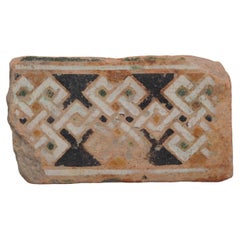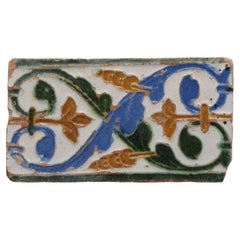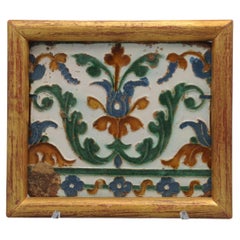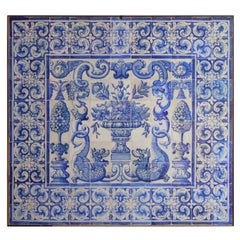Estadio of Spain Furniture
5
to
5
5
5
5
5
5
5
5
5
5
5,224
4,014
2,455
2,235
Creator: Estadio of Spain
Spanish Azulejo Arabe / Mudejar Tile - Arista y Cuenca - 15th century
By Estadio of Spain
Located in DELFT, NL
Early Arabe / Mudejar style tile with geometric decoration, made late 15th century.
Category
15th Century and Earlier Spanish Renaissance Antique Estadio of Spain Furniture
Materials
Earthenware
Spanish Azulejo Tile Arista y Cuenca - Toledo 16th century
By Estadio of Spain
Located in DELFT, NL
Early Arista y cuenca tile made in Toledo. Tile decorated in renaissance with stylized flowers was probably made between 1550 and 1575.
Category
16th Century Spanish Renaissance Antique Estadio of Spain Furniture
Materials
Earthenware
Spanish Azulejo Tile Arista y Cuenca - Toledo 16th century
By Estadio of Spain
Located in DELFT, NL
Early Arista y cuenca tile made in Toledo. Tile decorated in renaissance with stylized flowers was probably made between 1550 and 1575.
Category
16th Century Spanish Renaissance Antique Estadio of Spain Furniture
Materials
Earthenware
Spanish Azulejo Tile Arista / Cuenca - Toledo 16th century
By Estadio of Spain
Located in DELFT, NL
Early Arista / border tile made in Toledo. Tile decorated in renaissance with stylized flowers was probably made between 1550 and 1575.
Catalogue: La Azulejería Toledana a Través ...
Category
16th Century Spanish Renaissance Antique Estadio of Spain Furniture
Materials
Earthenware
Spanish Azulejo Tile Arista y Cuenca - Toledo 16th century
By Estadio of Spain
Located in DELFT, NL
Early Arista y cuenca tile made in Toledo. Tile decorated in renaissance with stylized flowers, probably made between 1550 and 1575.
Category
16th Century Spanish Renaissance Antique Estadio of Spain Furniture
Materials
Earthenware
Related Items
18th Century Portuguese "Azulejos" Panel "Vase"
By Europa Antiques
Located in Madrid, ES
18th century Portuguese "Vase"
Measures: 154cm x 140cm
110 tiles
Important note: This panel is with the tiles restored 17th century.
The panel is delivered as if it were a pai...
Category
18th Century Portuguese Baroque Antique Estadio of Spain Furniture
Materials
Ceramic
Italian Renaissance Plate, Patanazzi Workshop Urbino, End of 16th Century
By Patanazzi Workshop
Located in Milano, IT
Acquareccia plate
Patanazzi workshop
Urbino, last quarter of the 16th century
It measures diameter 17.12 in; foot diameter 11.53 in; height 1.88 in (43.5 cm; 29.3 cm; 4.8 cm).
Weight
State of conservation: wear and a few small minimal detachments of enamel, chipping on the raised areas, peeling of enamel at the brim on the back.
This large, shallow basin is equipped with a wide and convex well. It is umbonate with a contoured center. The brim, short and flat, is enclosed in a double rounded and barely raised edge. The basin has a flat base without rims; it has a slightly concave center in correspondence to the well.
The shape takes inspiration from the basins associated with the metal forged amphora pourers that traditionally adorned the credenza. These were used from the Middle Ages to wash hands during banquets. Two or three people washed their hands in the same basin and it was considered an honor to wash one’s hands with an illustrious person.
The decoration is arranged in concentric bands with, in the center of the umbo, an unidentified shield on a blue background: an oval banded in gold with a blue head, a gold star and a field with a burning pitcher.
Rings of faux pods separate the center from a series of grotesque motifs of small birds and masks. These go around the basin and are, in fact, faithfully repeated on the brim. The main decoration develops inside the flounce of the basin, which sees alternating symmetrical figures of winged harpies and chimeras. The ornamentation, outlined in orange, green and blue, stands out against the white enamel background.
This decorative style, defined since the Renaissance as “grottesche” or “raffaellesche”, refers to the decorations introduced after the discovery of the paintings of the Domus Aurea towards the end of the fifteenth century. The discovery of Nero's palace, buried inside Colle Oppio by damnatio memoriae, occurred by chance when a young Roman, in 1480, fell into a large crack which had opened in the ground on the hill, thus finding himself in a cave with walls covered with painted figures.
The great artists present in the papal city, including Pinturicchio, Ghirlandaio, Raffaello, immediately visited these caves. The decorations found there soon became a decorative subject of immense success: the term grotesque , with the meaning of “unusual,” “caricatured,” or “monstrous,” was later commented by Vasari in 1550 as “una spezie di pittura licenziose e ridicole molto”( “a very licentious and ridiculous kind of painting”).
The decorations “a grottesche” also widely circulated in ceramic factories, through the use of engravings, variously interpreted according to the creativity of the artists or the requests of the client.
Our basin is reflected in similar artifacts produced at the end of the sixteenth century by the factories of the Urbino district. See the series of basins preserved in the main French museums, among which the closest in morphology is that of the Campana collection of the Louvre (Inv. OA1496); this however has a more complex figure decoration, while the decoration of our specimen is sober and with a watercolor style.
The style, sure in its execution, approaches decorative results still close to the works produced around the middle of the sixteenth century by the Fontana workshop. The decoration is closely linked to their taste, which later finds its natural outlet, through the work of Antonio, also in the Patanazzi workshop. Studies show the contiguity between the two workshops due to the kinship and collaboration between the masters Orazio Fontana and Antonio Patanazzi, both trained in the workshop of Guido Fontana il Durantino. It is therefore almost natural that their works, often created according to similar typologies and under the aegis of the same commissions, are not always easily distinguishable, so much so that the presence of historiated or “grottesche” works by Orazio is documented and preserved in Antonio Patanazzi's workshop. Given that the studies have always emphasized the collaboration between several hands in the context of the shops, it is known that the most ancient “grottesche” works thus far known, can be dated from 1560, when the Fontana shop created the so-called Servizio Spagnolo (Spanish Service) and how, from that moment on, this ornamentation became one of the most requested by high-ranking clients. We remember the works created for the Granduchi di Toscana, when Flaminio Fontana along with his uncle Orazio supplied ceramics to Florence, and, later, other commissions of considerable importance: those for the service of the Duchi d’Este or for the Messina Farmacia of Roccavaldina, associated with the Patanazzi workshop when, now after 1580, Antonio Patanazzi began to sign his own work.
Thus, in our basin, the presence of masks hanging from garlands, a theme of more ancient memory, is associated in the work with more advanced stylistic motifs, such as the hatching of the chimeras and harpies. These are found here on the front with the wings painted in two ornate ways. In addition, the theme of the birds on the edge completes the decoration along the thin brim and can be seen as representing an early style typical of the Urbino district during a period of activity and collaboration between the two workshops. Later, a more “doll-like” decorative choice, typical of the end of the century and the beginning of the seventeenth century, characterized the period of the Patanazzi workshop under the direction of Francesco.
Bibliography:
Philippe Morel, Il funzionamento simbolico e la critica delle grottesche nella seconda metà del Cinquecento, in: Marcello Fagiolo, (a cura di), Roma e...
Category
16th Century Italian Renaissance Antique Estadio of Spain Furniture
Materials
Maiolica
A Deruta Maiolica Dish Early 16th Century
Located in Firenze, IT
SHIPPING POLICY:
No additional costs will be added to this order.
Shipping costs will be totally covered by the seller (customs duties included).
The centre painted with archaic de...
Category
16th Century Italian Renaissance Antique Estadio of Spain Furniture
Materials
Maiolica
Early 15th Century Orvieto Jug with Mythical Beast
Located in Pease pottage, West Sussex
Tin Glazed Earthenware with vivid green and manganese brown decoration on buff clay with a clear lead glaze. Orvieto, Early 15th Century Circa 1420. Similar Example Found in The Louv...
Category
15th Century and Earlier Italian Antique Estadio of Spain Furniture
Materials
Earthenware
Silver Ceremonial Cup, Spain, 16th Century
Located in Madrid, ES
Catavinos or scrapie. Silver in its color. Spain, 16th Century.
With contrast marks, illegible.
Cup without foot or handles, in silver in its color and with a circular base, flar...
Category
16th Century Spanish Renaissance Antique Estadio of Spain Furniture
Materials
Silver
17th Century Portuguese " Azulejos " Panel " Vase "
By Europa Antiques
Located in Madrid, ES
17th century Portuguese " Vase "
100cm x 85cm
42 tiles
Important note: This panel is with the tiles restored 17th century.
The panel is delivered as if it were a painting with a wo...
Category
17th Century Portuguese Baroque Antique Estadio of Spain Furniture
Materials
Ceramic
18th Century Portuguese "Azulejos" Vases"
By Europa Antiques
Located in Madrid, ES
18th century Portuguese "Vases"
Measures: 312 cm x 210 cm
Important note: This panel is with the tiles restored 18th century.
The panel is delivered as if it were a painting ...
Category
18th Century Portuguese Baroque Antique Estadio of Spain Furniture
Materials
Ceramic
Silver Drinking Cup, Spain, 16th Century
Located in Madrid, ES
Also known as "catavinos", this type of drinking cups were used on special occasions (ceremonies ...), hence their material and the decoration they have, and were very common during the reign of the Habsburgs in Spain. Although they were objects of civil use, it was not strange that they were donated or ordered for their use in churches or in liturgical areas. Both the decoration and the shape of the cup show the origin of the same artistic core away from the main silversmith centers. Compare, for example, with the "bernegal" with handles in the form of cartons from the Museo del Prado in Madrid (catalog O00085) made in the late 16th century, which presents the upper part carved in concave double gallons and shows vegetable prints...
Category
16th Century Spanish Renaissance Antique Estadio of Spain Furniture
Materials
Silver
18th Century Portuguese " Azulejos " Angels "
By Europa Antiques
Located in Madrid, ES
18th Century Portuguese " Angels "
Measures: 84 cm x 70 cm
30 Tiles.
Important note: This panel is with the tiles restored 18th century.
The panel is delivered as if it were a...
Category
18th Century Portuguese Baroque Antique Estadio of Spain Furniture
Materials
Ceramic
18th Century Portuguese "Azulejos" The Virgen"
By Europa Antiques
Located in Madrid, ES
18th century Portuguese " Angels "
Measures: 364 cm x 252 cm
439 tiles
Important note: This panel is with the tiles restored 18th century.
The panel is delivered as if it were...
Category
18th Century Portuguese Baroque Antique Estadio of Spain Furniture
Materials
Ceramic
17th Century Portuguese "Azulejos" Panel "Vase"
By Europa Antiques
Located in Madrid, ES
17th Century Portuguese " Vase "
Measures: 73cm x 87cm
30 tiles
Important note: This panel is with the tiles restored 17th century.
The panel is delivered as if it were a pai...
Category
17th Century Portuguese Baroque Antique Estadio of Spain Furniture
Materials
Ceramic
18th Century Portuguese "Azulejos" Panel "Vase"
By Europa Antiques
Located in Madrid, ES
18th century Portuguese "Vase"
Measures: 126cm x 126cm
81 tiles
Important note: This panel is with the tiles restored 17th century.
The panel is delivered as if it were a pain...
Category
18th Century Portuguese Baroque Antique Estadio of Spain Furniture
Materials
Ceramic
Estadio Of Spain furniture for sale on 1stDibs.
Estadio of Spain furniture are available for sale on 1stDibs. These distinctive items are frequently made of earthenware and are designed with extraordinary care. If you’re looking for additional options, many customers also consider furniture by Guitou Knoop, Jiri Krejcirik, and InsidherLand . Prices for Estadio of Spain furniture can differ depending upon size, time period and other attributes — on 1stDibs, these items begin at $246 and can go as high as $246, while a piece like these, on average, fetch $246.
Questions About Estadio of Spain Furniture
- 1stDibs ExpertApril 5, 2022Yes, there are three Balenciaga boutiques in Spain; one in Barcelona, one in Madrid and finally there is a Balenciaga store located in Zarautz. Considering the brand got its start in Spain, you’d think there would be more stores. However, moving the headquarter to Paris so long ago makes that city almost more like the home of Balenciaga. On 1stDibs, find vintage and contemporary Balenciaga haute couture from top sellers from around the world.
- 1stDibs ExpertMay 5, 2023No, Hermès sandals are not made in Spain. The luxury fashion house's iconic Oran sandals share a name with Spanish Oran, a Spanish-held territory in Algeria that existed during the 16th, 17th and 18th centuries, but the shoes are actually manufactured in-house in factories in Italy. On 1stDibs, shop a range of Hermès sandals.





